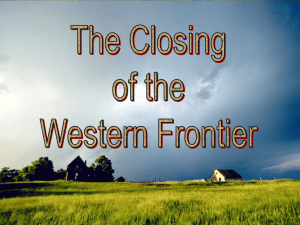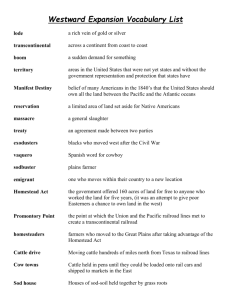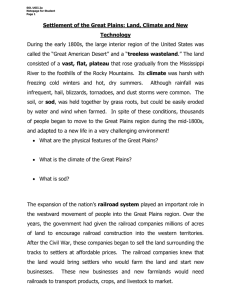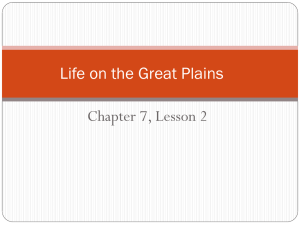File
advertisement
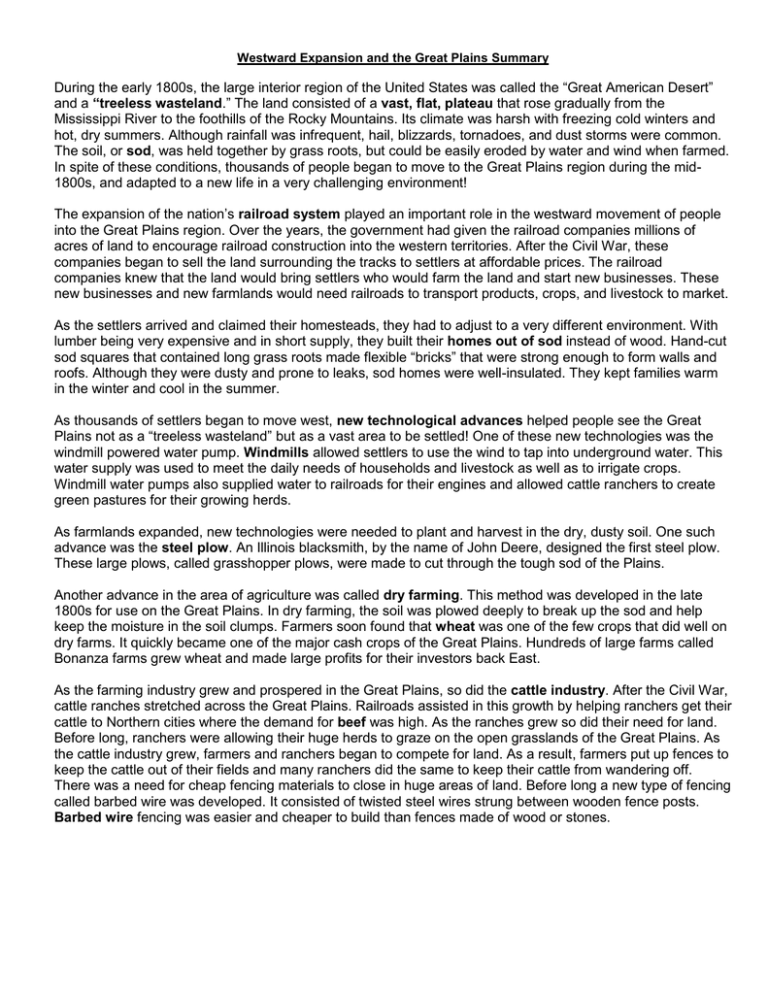
Westward Expansion and the Great Plains Summary During the early 1800s, the large interior region of the United States was called the “Great American Desert” and a “treeless wasteland.” The land consisted of a vast, flat, plateau that rose gradually from the Mississippi River to the foothills of the Rocky Mountains. Its climate was harsh with freezing cold winters and hot, dry summers. Although rainfall was infrequent, hail, blizzards, tornadoes, and dust storms were common. The soil, or sod, was held together by grass roots, but could be easily eroded by water and wind when farmed. In spite of these conditions, thousands of people began to move to the Great Plains region during the mid1800s, and adapted to a new life in a very challenging environment! The expansion of the nation’s railroad system played an important role in the westward movement of people into the Great Plains region. Over the years, the government had given the railroad companies millions of acres of land to encourage railroad construction into the western territories. After the Civil War, these companies began to sell the land surrounding the tracks to settlers at affordable prices. The railroad companies knew that the land would bring settlers who would farm the land and start new businesses. These new businesses and new farmlands would need railroads to transport products, crops, and livestock to market. As the settlers arrived and claimed their homesteads, they had to adjust to a very different environment. With lumber being very expensive and in short supply, they built their homes out of sod instead of wood. Hand-cut sod squares that contained long grass roots made flexible “bricks” that were strong enough to form walls and roofs. Although they were dusty and prone to leaks, sod homes were well-insulated. They kept families warm in the winter and cool in the summer. As thousands of settlers began to move west, new technological advances helped people see the Great Plains not as a “treeless wasteland” but as a vast area to be settled! One of these new technologies was the windmill powered water pump. Windmills allowed settlers to use the wind to tap into underground water. This water supply was used to meet the daily needs of households and livestock as well as to irrigate crops. Windmill water pumps also supplied water to railroads for their engines and allowed cattle ranchers to create green pastures for their growing herds. As farmlands expanded, new technologies were needed to plant and harvest in the dry, dusty soil. One such advance was the steel plow. An Illinois blacksmith, by the name of John Deere, designed the first steel plow. These large plows, called grasshopper plows, were made to cut through the tough sod of the Plains. Another advance in the area of agriculture was called dry farming. This method was developed in the late 1800s for use on the Great Plains. In dry farming, the soil was plowed deeply to break up the sod and help keep the moisture in the soil clumps. Farmers soon found that wheat was one of the few crops that did well on dry farms. It quickly became one of the major cash crops of the Great Plains. Hundreds of large farms called Bonanza farms grew wheat and made large profits for their investors back East. As the farming industry grew and prospered in the Great Plains, so did the cattle industry. After the Civil War, cattle ranches stretched across the Great Plains. Railroads assisted in this growth by helping ranchers get their cattle to Northern cities where the demand for beef was high. As the ranches grew so did their need for land. Before long, ranchers were allowing their huge herds to graze on the open grasslands of the Great Plains. As the cattle industry grew, farmers and ranchers began to compete for land. As a result, farmers put up fences to keep the cattle out of their fields and many ranchers did the same to keep their cattle from wandering off. There was a need for cheap fencing materials to close in huge areas of land. Before long a new type of fencing called barbed wire was developed. It consisted of twisted steel wires strung between wooden fence posts. Barbed wire fencing was easier and cheaper to build than fences made of wood or stones. Great Plains Summary Questions Name:______________________ 1. What are the physical features (how it looks) of the Great Plains? What is climate (weather over long periods)? 2. What is sod? 3. _____Which of the following had the largest influence on Westward Expansion into the Great Plains? A. Sod Houses C. Railroads B. Barbed Wire D. Dry Farming 4. Cause and Effect: Cause: Few trees existed on the Great Plains and lumber was expensive to ship to new settlers. Effect: 5. Cause and Effect: Cause: New Technological Advances are introduced to the Great Plains Effect: 6. Fill in the Chart: Invention/Adaptation How did it work?/What did it do? How did it help Plains Settlers? Windmills Allowed settlers to cut through the thick sod for farming. Old wooden plows were too weak for the tough Great Plains sod. Dry Farming Wheat Beef Cattle Industry Twisted steel wire strung between wooden posts that formed fences.


